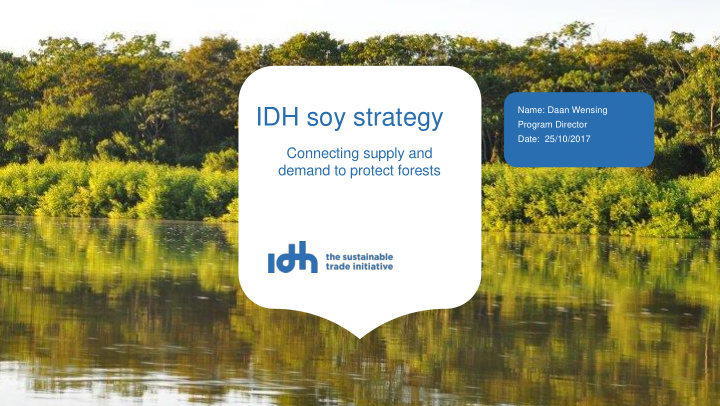



Name: Daan Wensing IDH soy strategy Program Director Date: 25/10/2017 Connecting supply and demand to protect forests
Global Convening Local Convening 11 sector programs 12 landscapes Mato Grosso, West Kalimantan, South Sumatra & Aceh, Brazil Indonesia Jambi Indonesia Tea Coffee Cotton Cocoa soy, beef palm oil, pulp & paper, palm oil, rubber, palm oil rubber, timber pulp & paper Aquaculture Palm oil Apparel Tropical Timber Central Highlands, Wider Taï Forest area, Central Rift Valley , South West Mau Forest, Côte d’Ivoire Vietnam Ethiopia Kenya coffee, spices (pepper) cocoa, timber, rubber flowers, fruit & vegetables tea Fresh & Soy Pulp & Paper Ingredients South East Western Nimba, Liberia Liberia Liberia palm oil palm oil mining
Where are we now? Soy ~7.6 MMT Responsible imported by EU 28 (of 34.5 MMT total 2015/2016) Monitoring system in development No traceability to farm/ region Supply chain models to develop direct link: in development
Step-wise approach step 3 Supporting the purchase of RTRS or equivalent step 2 Supporting farmers that are legally compliant towards zero net deforestation step 1 Supporting farmers towards legality
Why? Objective is for responsible soy and palm to become mainstream. We 1 therefore need to work with mainstream producers. Gives the producer a central position, instead of end- buyers or NGO’s. 2 Most farmers are not legally compliant. What does he/she need to get there? So a bottom up approach, instead of focusing on niche, which recognizes 3 steps already made.
Strategy to achieve soy program targets 1.Governance • Soy Supporting RTRS to gain commitment for responsible soy • Targets Monitoring 1. 50% of European soy import • 2. Field Development and operationalization of verified sourcing areas being responsible, + 100% by CGF companies 2. Raise the bar on soy sourcing 3. Market • Convening retail & trade and investors. guidelines to incorporate zero- • Implementation of MoU with Aprosoja, Abiove, Fefac and net-deforestation Fediol, including: 3. Develop a direct sourcing o work on supply chain models; connection between the end- o project with Fefac on ZND, monitoring buyer and the producer. o Project with Aprosoja on improving production & VSA’s
Verified Sourcing Areas - I PPI compact An agreement between public, private (incl farmers), civil society (incl community) stakeholders to enhance the sustainability and productivity of land and secure community livelihoods in exchange for forest/natural resources protection. Objective: to turn region into a verified sourcing area. Native Rainforest Village River Palm Oil Jurisdictional Boundries Other Agricultural Land City Mining Areas Cocoa Landscape Boundries
Verified Sourcing Areas - II Verified sourcing areas are: 1. Beneficial to the region; 2. Defined areas; 3. With a clear governance structure; 4. Monitored by a set of simple indicators (public & aggregated farmer data); 5. With a link to the domestic & export markets
Verified Sourcing Areas III – Example Sorriso, Mato Grosso TOTAL FARM AREA 1.826.535 ha Productive Land: 1.279.735 ha Forest Cover: 546.801 ha PROPERTIES 200, covering at least 50% productive land PROJECT TARGETS 400 ha app restored; 10% annual continuous improvement
*domestic consumption = in part carrying over, part crushed, and then 50% of that crush is exported
Thank you.
Recommend
More recommend